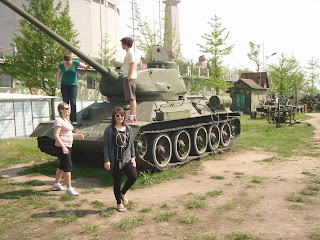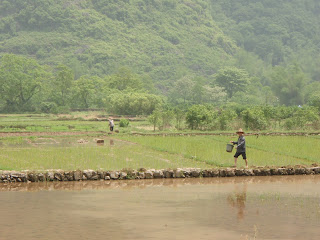Day two in Dandong saw us delving deep into the Korean War from the Chinese perspective. It was incredibly interesting to visit the Museum to Commemorate US Aggression in Korea. The museum was well put together, had extensive English captions and was a really in depth look at China’s contribution to the Korean war. The photos were really incredible, but it was the captions that really had us thinking. They showed a very different point of view about the war then that which we in Canada are likely to see in a history book.
As a historian, Paul likes to point out bias when he sees it. However, the signs made it very clear that the information in the museum was only open to interpretation by the museum staff and that any differing opinions were not to be expressed. While none of us know enough about the Korean war to check the Chinese museum’s claims about death tolls, etc. it was the loaded language that was really hard to deal with. Paul took lots of pictures to show future classes of Social Studies Eleven.
 |
| Propaganda floated downstream to the UN troops by Chinese and North Korean Soilders |
 |
| This man was apparently tatooed against his will by UN forces while in the POW camp, funny thing is the tatoos are in Chinese. |
After we had wandered around the museum for a number of hours, we headed outside. For the next few minutes we wandered around a field of tanks, anti-aircraft guns, radar installations, mig fighter planes and other military materiel. In fact we climbed in, on and around all of this equipment like children at a jungle gym. So much fun squishing three grown men into a Korean War era tank and yelling “Down with the imperialist pigs!”
The rest of the afternoon was spent walking on the broken bridge that used to connect the Chinese mainland with Korea before the US troops “accidentally” bombed it during a cease fire during the war (along with also accidentally destroying a hospital and airport). When we finally climbed back into the van, it was only for a few minutes, as we soon ran out of gas and were unable to find an open gas station. Eventually, our driver tracked down a jerry can full of fuel and got us to a gas station. Soon enough we were on our way back to our comparatively comfortable beds.
Reflections:
-North Korea has no electricity that we saw. None. You can make your own mind up about what that must show about the state of their economy.
-Korean food is fantastic. Silk worms... doable. Except for the fact that no one in Asia can seem to make a delicious breakfast food here is pretty darn good (when you know what to order).
-The wall is pretty great.
-Chinese clubs are hilarious.
-We know now what it feels like to be an eleven on the freak dial. Being some of the only tourists around was an interesting experience.
























































